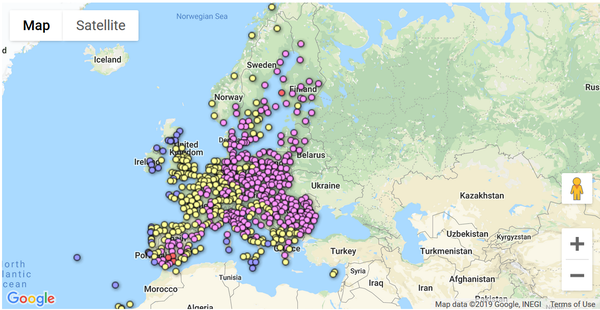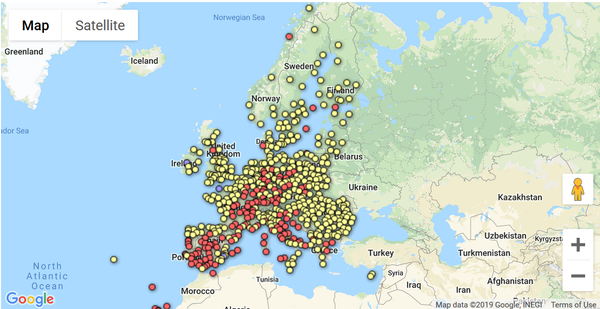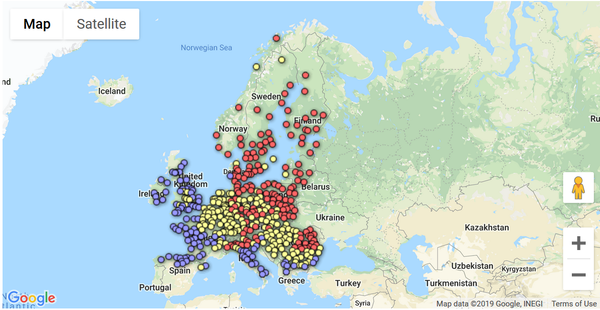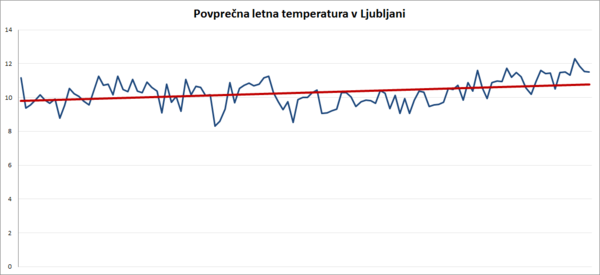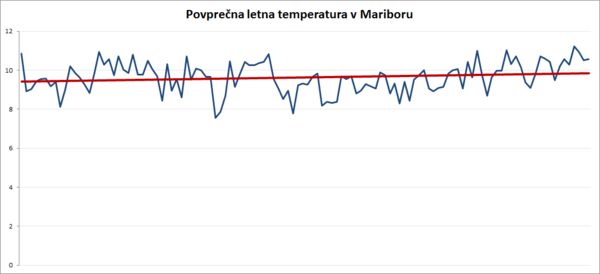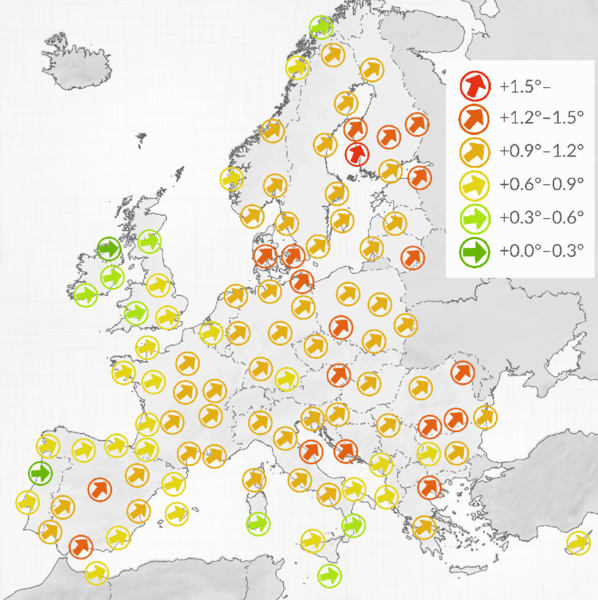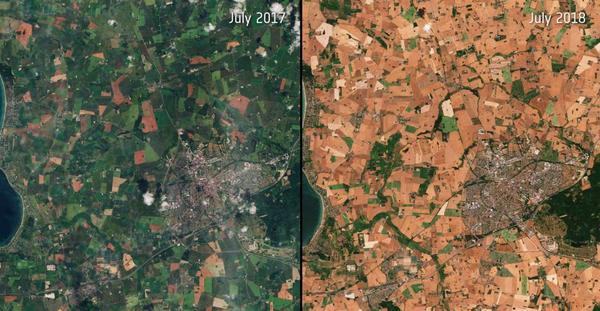It has become increasingly hot in Slovenia
An exclusive analysis of the EDJNet journalists, whose members we, Pod črto, are, reveals how fast the European cities are warming.

Ilustracija: Metod Blejec
It has become increasingly hot in Slovenia
An exclusive analysis of the EDJNet journalists, whose members we, Pod črto, are, reveals how fast the European cities are warming.
Ilustracija: Metod Blejec
The scenes of summer 2019 reminded of the images of biblical adversity in many European cities. In the vicinity of Hamburg, utility services had to remove several tons of dead freshwater fish that had run out of oxygen due to heat. In Sweden, huge fires raged, burning more than 25,000 hectares of forest, and the situation was even worse in Greece. The Swiss army delivered water by helicopters to dehydrated cattle in mountainous pastures. In the Finnish province of Utsjoki, to the north of the Arctic Circle, the temperatures exceeded 33°C in July. In Germany, France and Sweden, nuclear power plants had to be suspended as too warm rivers could not cool reactors. At the hospital in Maribor, doctors warned about the impossible situation when patients and staff were “cooking” in under-conditioned operating theatres.
The heatwave of summer 2019 showed what many future European summers will be like, according to expert forecasts. They will be characterized by record temperatures, extreme weather phenomena and natural disasters (e.g. forest fires, droughts), more frequent power outages, and increased mortality among vulnerable groups of population, especially the sick, the elderly and the poor. City dwellers will be strongly affected by hot summers, as cities can heat up to five degrees or more than their surroundings. The cities are considered to be some kind of “heat islands”, which accumulate a lot of heat due to overheated asphalt and concrete surfaces and do not cool down at night. This is a heavy heat load on their residents, resulting in the death of more than 70,000 Europeans in the heatwave of 2003, according to data from 16 European countries.
The forecasts that this summer of was not going to be an exception are confirmed by the data analyzed by EDJNet. EDJNet journalists have obtained more than one hundred million measurements from the European Center for Medium-Term Weather Forecasts (ECMWF). Those data came from various sources: ground measuring stations, meteorological balloons, buoys and satellite images. The methodology considered the effects of notable values, which could have impacted on the results (a measuring station located in a city center will record much higher temperatures than the one in the surroundings due to the effect of the heat island). This allowed us to compare data between individual areas over different time periods, so we could see how much European cities had warmed up on average since 1900.
The centennial analysis covered more than 500 European cities. As a starting point, the goals of the 2015 Paris Environmental Compact were set, where the UN member states have committed themselves to limiting the average warming of the atmosphere to 1.5°C compared to the pre-industrial era. A comparison of the measurements showed that some European cities have already reached this value. Certain parts of northern Europe (Finland and Denmark), Andalusia and mainland Europe (Romania) are fastest-warming regions. In parts of Spain and Finland, the average temperatures of the 21st century (2000-2018) were already more than 1.5°C higher than in the 20th century. The city of Granada heated up the most, with an average temperature higher by 1.6°C in the 21st century than in the 20th century.
On the other hand, the western and some southern parts of Europe are warming up slowly. Ireland and the north of the United Kingdom, the Canary Islands, the south of Sicily, Malta and Sardinia have warmed by less than 0.5°C.
Map of European cities by temperature rise. Blue indicates cities where the average annual temperature has risen up to 0.5°C between the two centuries; yellow indicates cities where the temperature has risen between 0.5°C and 1°C during the same period; pink indicates cities where the temperature has risen between 1°C and 1.5°C; red indicates cities where the temperature rose by more than 1.5°C. Data source: ECMWF, EDJNet calculations.
In addition to temperature changes, the number of above-average hot and cold days in European cities was calculated.
An above-average hot day in a particular city is identified as a day where the average daily temperature was more than twice the standard deviation from the average temperature of the city during the entire period studied. The above-average hot days in Ljubljana are considered those on which the average full-day temperature exceeds 26°C. In Tromsø, Norway, for example, an above-average hot day is the one when the average all-day temperature exceeds 15°C.
The number of hot days in the selected European cities has increased by an average of four days per year in the 21st century. In European countries, the number of hot days has increased most on the Canary Islands. If Las Palmas had an average of six above-average hot days per year in the 20th century, that number increased to 34 days in the last 17 years. On the contrary, in some cities in Ireland, France and Spain, the number of hot days has even decreased. The number of above-average hot days decreased in four cities out of a total of 558.
Map of European cities according to changes in the average number of hot days per year between the 20th and 21st centuries. Blue indicates cities in which there were fewer hot days in the 21st century than in the 20th century. Yellow indicates cities in which, on average, there were up to five more hot days per year in the 21st century than in the 20th century; red indicates cities with an average of more than five hot days per year in the 21st century compared to the 20th century. Data source: ECMWF, EDJNet calculations.
In addition to the increase in the number of hot days, the number of cold days in European cities has been also decreasing. A cold day is defined as the one on which the daytime temperature does not exceed –1°C. On average, there are seven cold days less per year in the European cities in the 21st century than in the previous century. The expected number of cold days has decreased most in the northern part of Europe. In the past century, the Finnish city of Pori recorded an average of 85 cold days per year, with only 59 in the last 17 years. A change is also noticeable in the Alps. In the Italian city of Bolzano, the number of cold days has decreased by nine days per year, on average.
Map of European cities according to changes in the average number of cold per year between the 20th and 21st centuries. Blue indicates cities in which there were up to five cold days less on average in the 21st century than in the 20th century. Yellow indicates cities in which there were an average of five to ten cold days less per year in the 21st century than in the 20th century; red indicates cities in which there were less than 10 cold days per year on average compared to the 20th century (cities in hot climates are not included in the map). Data source: ECMWF, EDJNet calculations.
Ljubljana is heating up faster than its surroundings
Two Slovenian cities were included in the analysis: Ljubljana and Maribor. Ljubljana ranked 68th on the comparative scale among 558 European cities. The average temperature increased by 1.2°C in the last 18 years compared to the 20th century average. The number of hot days per year increased by an average of 2.6 days, and the number of cold days slightly decreased – from 33 to 22. In the 21st century, Ljubljana warmed much faster than the surrounding cities, as it “overtook” Zagreb ranked 164th, Trieste 226th, Klagenfurt 362nd, Graz 364th and Maribor 418th.
Diagram: Metod Blejec (Average annual temperature in Ljubljana)
In Maribor, the average temperature rose by 0.8°C in the 21st century, ranking it 425th. The number of hot days increased from 0.2 to 1.9, while the number of cold days decreased slightly – from 41 to 36. In comparison to the surrounding areas, Maribor warmed up more slowly, as all the surrounding places were ranked higher on the scale.
Increase in the average annual temperature in Maribor between 1900 and 2017. The red line indicates the trend. Source: ECMWF, EDJNet calculations.
The relatively fast warming of Ljubljana can be surprising, as the city is small and has a large proportion of green surfaces (Tivoli park, castle hill…), the river and other water areas that cool the surroundings. Factors contributing to warming include the basin position, relatively weak winds and the effects of global climate changes that Ljubljana cannot avoid. “The average temperature has risen in Slovenia [according to the ARSO measurements] by 2°C since 1961, which is one degree more than the global average. In Ljubljana, however, it has increased by another half a degree due to the thermal effect of the city, “said Mojca Dolinar, who runs the climate analysis sector at the Slovenian environmental agency ARSO.
More extreme weather phenomena
“The most difficult thing to do is simply explain what changes these two degrees bring about,” said Mojca Dolinar. “It is not a problem, if April is two degrees warmer. On the contrary, we look forward to the warm spring as we had it this year. We do not mind if today is 27°C instead of 25°C. However, if it is considered that average temperatures in Ljubljana and Gorizia differ by 2°C, then it can be imagined how different climates these are.”
Mojca Dolinar explained that a two-degree increase in the average temperature causes major changes in the precipitation regime and increases the possibility of extreme weather phenomena, especially droughts, floods, hail, strong winds and heat waves. These processes are interconnected. Weather models in our geographical latitudes have shown that warmer atmosphere absorbs more moisture before precipitation develops. This means that longer periods of time can pass between individual rainfall (danger of drought) and the rainfall is more intense due to accumulated energy and causes torrential floods. “Although these extreme phenomena have already been known before the greenhouse effect, measurements and forecasts indicate that they will become more frequent in the coming decades.”
This means that Ljubljana, in particular, is fully exposed to torrential floods, said Mojca Dolinar. “Because the city lies in a basin, water flows in it from all directions. The consequences are best seen when very heavy rainfall pours down on the Polhov Gradec Hills. The torrential waters flow into the valley and flood the Ljubljana moors. Due to the growing build-up, the water cannot drain and remains on the surface. ”The worst floods were in 2010 and 2014 and they also reached some parts of Ljubljana, especially those along the Gradaščica and Mali Graben streams.”
During the future weather changes, Mojca Dolinar pointed out also changes in the precipitation regime (where there is already a small amount of precipitation, there will be even less) and thinning of a snow cover. “All the scenarios show that there will be more precipitation in winter in Slovenia, but rail will prevail. The snow cover has already shrunk dramatically compared to the one was measured in the 1960s and 1970s, especially in the mid-mountain range. Even if a lot of snow falls at one go, it won’t last long.”
The lack of snow will not only affect winter tourism and ski operators – in Maribor this year, the Golden Fox ski competition had to be cancelled as many times in recent years – but also the entire water cycle. “The snow cover remains until spring or early summer before it melts and fills our rivers,” said Mojca Dolinar. Less snow in the mountains means less water in the rivers in spring and summer. This, among other things, has negative effects on the operation of hydropower plants.
Red arrows indicate intensive warming, green ones indicate less intensive warming.
Dangerous heatwaves
The change that city dwellers will feel most and directly is the summer heatwaves. In last year’s Proceedings on Natural Disasters in Cities, published by the Research Centre of the Slovenian Academy of Sciences and Arts (ZRC SAZU), heatwaves were classified as natural disasters along with floods and earthquakes.
Researchers Mateja Zalar, Tjaša Pogačar, Zalika Črepinšek and Lučka Kajfež-Bogataj defined a heatwave as a series of at least five consecutive days with a maximum daily temperature exceeding 29.5°C. They showed that the incidence and intensity of heatwaves in Ljubljana increased significantly between 1978 and 2015, as did the number of days with a maximum temperature above 29.5°C. Such high temperatures have numerous negative consequences, the authors warn, as they affect the health and mortality of the population. Among others, they noted that productivity also decreases at higher temperatures, even by half, especially in demanding mental and physical work, which significantly increases the possibility of injuries at work.
A particularly severe heatwave hit Europe in 2003. It has not been so hot in Europe since at least 1540. At that time, the number of sick leave across Europe had grown from an average of 3 to almost 12 per cent on average. In that period, 70,000 people more died from high temperatures across Europe than in the normal (non-heat) period, 81 of which in Slovenia – which is about 13 per cent higher mortality than in the periods without heatwaves.
The drought has also hit countries that have not used to this phenomenon before. The photo shows a satellite image of fields and other green areas around the Danish Slagelse, which have almost disappeared due to lack of precipitation. Similar comparisons were made for other parts of Europe (photo by European Space Agency/Flickr).
A study on the effects of heatwaves in Slovenia was published earlier this year by Simona Perčič, Andreja Kukec, Tanja Cegnar and Ana Hojs. They found that heatwaves significantly increased mortality in 2003 and 2015 compared to the periods without extreme temperatures. The consequences of the heatwave accounted for 137 additional deaths in 2015, which was an increase of 7 per cent over the expected mortality rate. The elderly, women, and patients with diseases affecting the regulation of heat in the body (cardiovascular disease, diabetes, kidney disease, etc.) were more severely hit by the heat. Mortality was almost three times higher in urban areas than in rural ones, as the socio-economic factors along with the health played a very important role. People living alone and poorer residents were more endangered because they were often unable to cool their apartments by air-conditioning.
Taking into account the forecasts that the number and intensity of heatwaves will increase and that the population in Slovenia will continue to age, the effects of increased temperatures in cities will also be worse in cities every year, the researchers warn.
This will especially apply to cities because they heat up significantly more than their surroundings during a heat wave. Ziga Kokalj, a researcher at the Institute for Anthropological and Spatial Studies at ZRC SAZU, in cooperation with Blaž Komac, Rok Ciglič and Miha Pavšek analyzed the effects of an urban heat island in the aforementioned last year’s Proceedings on Natural Disasters in Cities. A thermal island is created because buildings and built-up land absorb solar energy and then emit it (heat it). Bricks, asphalt, concrete and other materials have a higher thermal capacity than the natural elements of the landscape (meadows, water…), and additional heat is also created by people (heating and cooling of buildings, traffic…). Due to the effect of the heat island, the temperature in the city center can be up to five degrees higher than in the surrounding area, depending on the settlement, construction, weather and season. The heat island has the strongest effect in summer and winter, and often it is found in the vicinity of industrial and commercial centers and in the city center.
What can city authorities do?
ARSO have prepared several climate scenarios concerning the effects of environmental changes on economic activities, natural systems and human health by the end of the 21st century.
It has been identified that South and South-East Europe belong to one of the most vulnerable areas, as both rising temperatures and decreasing precipitation significantly increase the risk of droughts, forest fires, floods and heat waves. The simulation results for Slovenia predict a significant increase in the average annual air temperature throughout the country in all seasons. Rainfall will significantly decrease in summer and increase in winter. There will be an increase in the number of warm days with a maximum temperature above 25°C and “tropical nights” when the temperature does not fall below 20°C even at night (which significantly increases the heat load). However, the number of cold days will decrease where the lowest temperature drops below freezing.
In Slovenian cities, heat waves will have to be treated as natural disasters and it will be necessary to search ways to mitigate the negative effects of higher temperatures on the health and productivity of the population. The European Heat Shield project develops information and alert systems for workers in the most exposed sectors: industry, transport, tourism, agriculture and construction. A similar system for Slovenia was proposed by the authors Mateja Zalar, Tjaša Pogačar, Zalika Črepinšek and Lučka Kajfež-Bogataj, who described the effects of heatwaves. In addition to the alert system, they recommended planning additional hospital beds during heatwaves and increasing the number of control doctors’ visits to the elderly and chronic patients. Better informing the population how to deal with heatwaves (drinking, exercising, proper use of air conditioning) would be also helpful.
Similar planning would be required to minimize the effect of a heat island. “Identifying thermal islands in individual cities and determining mitigation measures should be included in the mandatory components of local energy concepts in the future,” wrote Žiga Kokalj. This means adding green and water surfaces, designing air corridors and selecting building materials that better reflect light and accumulate less heat. Better energy planning for new buildings, thermal insulation of buildings and energy rehabilitation of buildings are vital importance.

